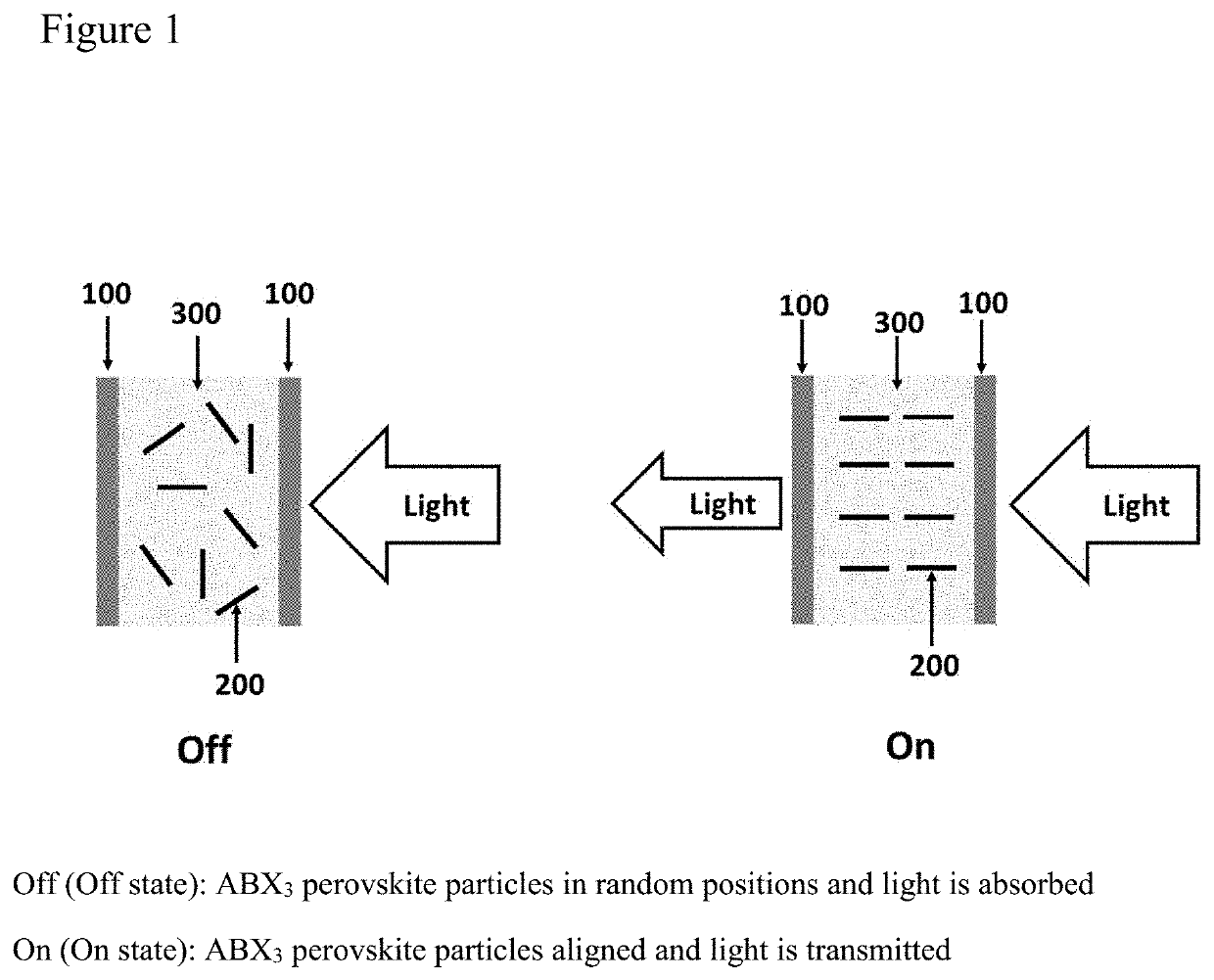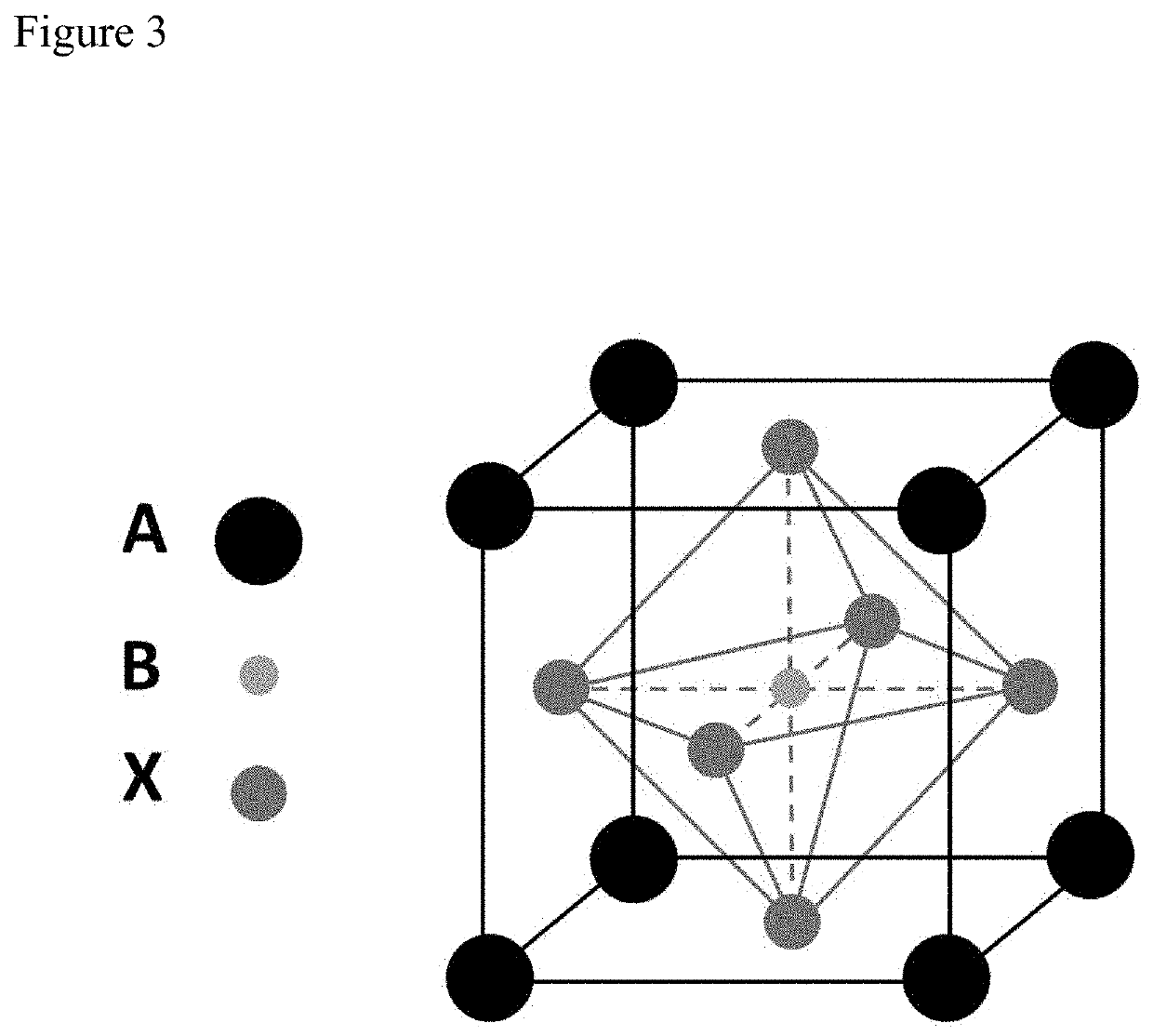Halide ABX3 perovskite particles and their application in controlling photo-flux
a technology of perovskite particles and light control valves, which is applied in the direction of lead halides, rubidium/caesium/francium compounds, instruments, etc., can solve the problem of no technology involving light control valves using abx/sub>3 perovskite materials
- Summary
- Abstract
- Description
- Claims
- Application Information
AI Technical Summary
Benefits of technology
Problems solved by technology
Method used
Image
Examples
example 1 preparation
of Cs-Oleate
[0023]Cs2CO3 (4.07 g) was loaded into a 250 mL, 3-neck flask along with octadecene (50 mL, ODE) and oleic acid (11.088 g), and the mixture was dried for 1 h at 120° C. and then heated under Ar to 150° C. until all Cs2CO3 reacted with oleic acid. Since Cs-Oleate precipitates out of ODE at room temperature, it has to be preheated to make it soluble before usage.
Example 2 Synthesis of CsPbI3 Nanorods
[0024]N, N-dimethylformamide (100 mL, DMF) and PbI2 2.306 (5 mmol) were loaded into a 250 mL flask. Acetate acid 4.654 g (77.5 mmol) and dodecylamine 0.797 g (4.3 mmol) were added. After complete solubilization of PbI2, 5 mL Cs-Oleate solution was added (prepared as described Example 1). Then, the hybrid solution was added into a 5 L flask along with 4200 mL toluene.
[0025]Then, centrifuge the reaction solution at 5000 G for 1.5 hours and discard the supernatant to yield the light control CsPbI3.
[0026]Then, the CsPbI3 were further dispersed with 500 mL of toluene, mixed well with...
example 6
LV Devices Made from LV Suspension-Example-4
[0030]In this example, a wet thickness of 200 um of the LV Suspension-Example 4 made in Example 4 was sealed between two transparent electrodes of ITO conductive glass using epoxy resin to produce a light valve referring as LV Device-6. When no electric voltage is applied (OFF State), LV Device-6 exhibits an orange tint and light transmission is measured to be 4.7%. When it was electrically activated using 220 Volts AC at 50 Hz (ON State), the LV Device-6 turns clearer and light transmission is measured to be 25.6%. FIG. 2 presents the absorption spectrum of LV Device-6 at OFF state and ON state respectively.
example 7
LV Devices Made from LV Suspension-Example-5
[0031]In this example, a wet thickness of 180 um of the LV Suspension-Example 5 made in Example 5 was sealed between two transparent electrodes of ITO conductive glass using epoxy resin to produce a light valve referring as LV Device-7. When no electric voltage is applied (OFF State), LV Device-7 exhibits an orange tint and light transmission is measured to be 6.4%. When it was electrically activated using 220 Volts AC at 50 Hz (ON State), the LV Device-7 turns clearer and light transmission is measured to be 30.2%.
TABLE 1Typical performance of LV devicesTransmittance %LV DeviceOff stateOn stateLV Device-64.725.6LV Device-76.430.2
PUM
 Login to View More
Login to View More Abstract
Description
Claims
Application Information
 Login to View More
Login to View More - R&D
- Intellectual Property
- Life Sciences
- Materials
- Tech Scout
- Unparalleled Data Quality
- Higher Quality Content
- 60% Fewer Hallucinations
Browse by: Latest US Patents, China's latest patents, Technical Efficacy Thesaurus, Application Domain, Technology Topic, Popular Technical Reports.
© 2025 PatSnap. All rights reserved.Legal|Privacy policy|Modern Slavery Act Transparency Statement|Sitemap|About US| Contact US: help@patsnap.com



